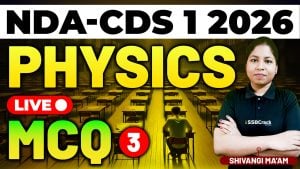A recent class on Differentiation and Differentiability for the NDA-NA Exam – Paper I – Maths delved into advanced topics of calculus. This session expanded on foundational concepts, introducing techniques like logarithmic differentiation, parametric differentiation, implicit differentiation, and higher-order derivatives, particularly the second derivative.
This engaging class balanced theoretical insights with problem-solving practice, ensuring students could confidently tackle related exam questions.
Key Highlights of the Class
1. Logarithmic Differentiation
The class began by introducing logarithmic differentiation, a powerful method used to simplify the differentiation of complicated functions. This approach is especially useful for functions involving products, quotients, or exponents. Students explored how logarithms help break down complex expressions, making differentiation manageable.
2. Parametric Differentiation
Parametric differentiation was another focus area. The instructor explained how to find derivatives when a curve is expressed in parametric form, with variables depending on a parameter. Practical examples demonstrated how to determine derivatives with respect to one variable, considering its dependence on another.
3. Implicit Differentiation
The discussion then moved to implicit differentiation, a technique for differentiating equations where the dependent and independent variables are intermingled. Real-world scenarios where this method is indispensable were highlighted, helping students understand its significance.
4. Higher-Order Derivatives
The concept of higher-order derivatives, particularly second-order derivatives, was introduced as a continuation of basic differentiation. The class explored their role in analyzing the concavity, acceleration, and behavior of functions.
Key Takeaways
- Simplify Complex Functions with Logarithms: Logarithmic differentiation is not only a computational tool but also a strategic one for simplifying intricate problems.
- Adapt to Parametric Representations: Understanding parametric differentiation expands versatility in dealing with non-standard representations of curves.
- Analyze Implicit Relationships: Implicit differentiation provides the ability to work with equations that don’t explicitly define one variable in terms of another.
- Higher-Order Derivatives Add Depth: These derivatives are essential for studying the detailed behavior of functions and interpreting real-world phenomena like motion and growth.
Strategies for Preparing Advanced Differentiation Topics
1. Understand Core Concepts
Before diving into advanced differentiation, ensure a solid grasp of basic derivatives. Understanding foundational techniques makes advanced topics easier to approach.
2. Practice Logarithmic Differentiation
Work through problems that require logarithmic differentiation, especially for functions with exponents, products, or quotients. It’s crucial to learn where this method is most effective.
3. Master Parametric Equations
Solve problems where functions are defined parametrically. Practice eliminating parameters and differentiating with respect to independent variables.
4. Get Comfortable with Implicit Differentiation
Focus on problems where the relationship between variables isn’t explicit. Develop confidence in applying implicit differentiation and interpreting the results.
5. Work on Higher-Order Derivatives
Explore problems involving second-order derivatives and their interpretations. Understanding their significance, especially in analyzing the nature of functions, will give you an edge.
6. Refer to Previous Years’ Questions
Review past NDA-NA exam questions to identify patterns and frequently tested concepts. This helps in targeting key areas during preparation.
7. Attempt Mock Tests
Simulate exam conditions with mock tests. Include questions involving logarithmic, parametric, and implicit differentiation, along with higher-order derivatives.
8. Clarify Doubts Promptly
Advanced topics can be tricky, so don’t hesitate to seek help. Engage with peers or instructors to resolve confusion early.
Conclusion
The class on advanced differentiation topics was a comprehensive exploration of essential techniques for the NDA-NA Exam. By focusing on logarithmic, parametric, and implicit differentiation alongside higher-order derivatives, students were equipped to tackle complex calculus problems effectively.
Preparing for this topic demands a blend of conceptual clarity and consistent practice. Understanding these advanced techniques is not just about scoring marks but also about gaining a deeper appreciation of calculus and its applications.
With diligent preparation and strategic practice, mastering advanced differentiation can significantly enhance your performance in the NDA-NA exam. Stay focused, practice regularly, and approach the topic with confidence. Success is within your reach!

















